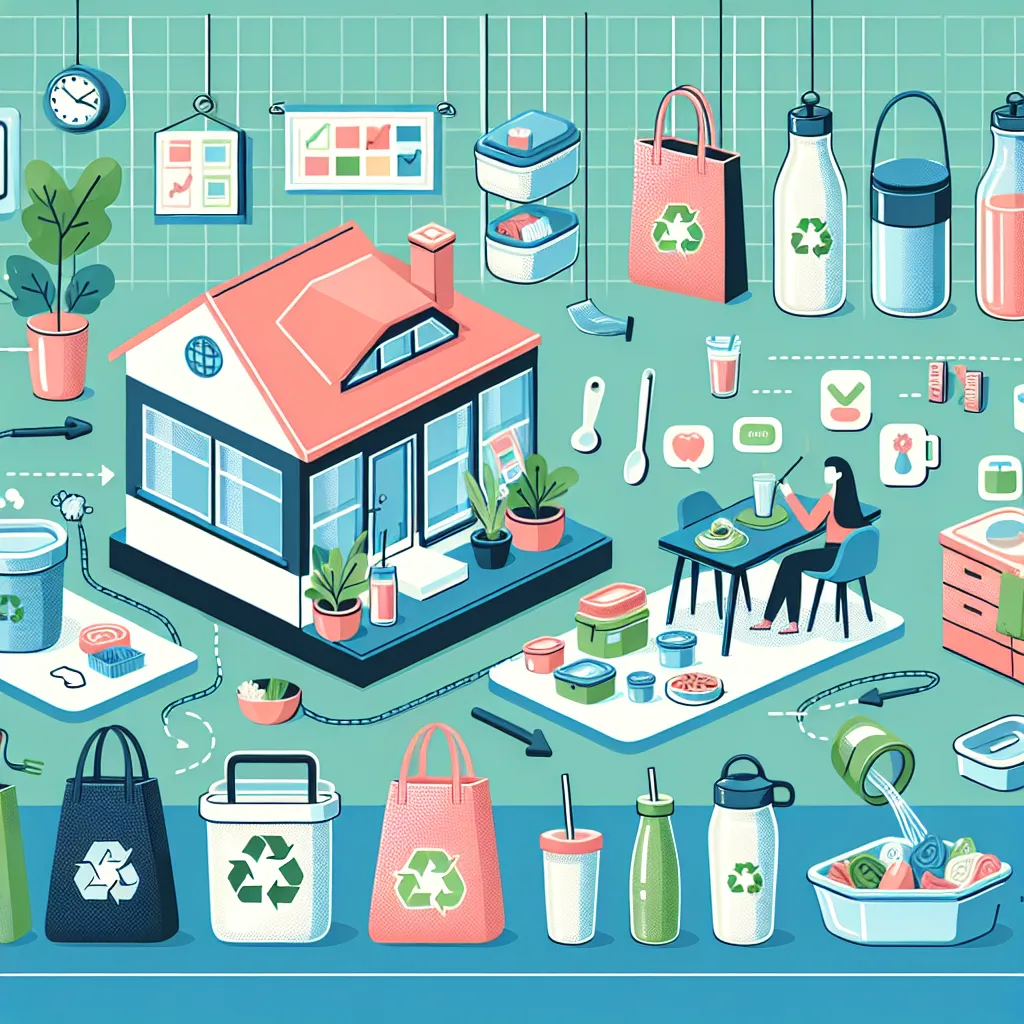The IELTS Reading section is a crucial component of the test, assessing your ability to comprehend complex texts and extract relevant information. Today, we’ll focus on a topic that has gained significant prominence in recent years: strategies for reducing plastic use in households. This subject has appeared frequently in IELTS exams, reflecting its global importance. Given its relevance to environmental issues and sustainable living, it’s highly likely that similar themes will continue to feature in future tests.
 Household plastic reduction strategies
Household plastic reduction strategies
IELTS Reading Practice Text
Plastic-Free Living: Strategies for Households
In recent years, the environmental impact of plastic pollution has become increasingly apparent, leading to a growing movement towards plastic-free living. Households play a crucial role in this shift, as daily choices can significantly reduce plastic consumption and waste. This article explores effective strategies for minimizing plastic use in homes, contributing to a more sustainable future.
One of the most straightforward approaches to reducing plastic use is replacing single-use items with reusable alternatives. Cloth shopping bags, for instance, can easily substitute plastic carrier bags. These durable options not only reduce waste but often prove more convenient for carrying groceries. Similarly, reusable water bottles and coffee cups can dramatically decrease the consumption of disposable plastic bottles and takeaway cups. Many cafes now offer discounts to customers who bring their own cups, providing an additional incentive.
Food storage presents another opportunity for plastic reduction. Glass or stainless steel containers can replace plastic Tupperware for leftovers and lunches. These alternatives are not only more environmentally friendly but also free from the chemicals that can leach from plastic into food. For wrapping foods, beeswax wraps or silicone covers offer excellent alternatives to plastic cling film.
Shopping habits can significantly impact household plastic consumption. Choosing products with minimal packaging or opting for items packaged in recyclable materials can make a substantial difference. Many supermarkets now offer loose fruits and vegetables, allowing customers to use their own bags or containers. Buying in bulk is another effective strategy, reducing the amount of packaging per unit of product.
Personal care products are often overlooked sources of plastic waste. Solid shampoo bars, soap bars, and toothpaste tablets can replace their bottled counterparts, eliminating the need for plastic packaging. Bamboo toothbrushes and reusable cotton pads for makeup removal are other eco-friendly alternatives gaining popularity.
While individual actions are crucial, community engagement can amplify the impact of plastic reduction efforts. Participating in local zero-waste initiatives, supporting businesses that prioritize sustainability, and advocating for policy changes can create a broader societal shift towards reduced plastic use.
Educating family members, especially children, about the importance of reducing plastic use is vital for long-term change. Making plastic reduction a family project can be both educational and rewarding, fostering a sense of environmental responsibility from a young age.
Despite these strategies, completely eliminating plastic from households remains challenging. Some items, particularly in healthcare and certain food products, still rely on plastic packaging for safety and hygiene reasons. In these cases, proper recycling becomes crucial. Understanding local recycling guidelines and ensuring that recyclable plastics are correctly sorted can minimize the environmental impact of unavoidable plastic use.
In conclusion, reducing plastic use in households requires a multifaceted approach. By combining simple swaps, mindful shopping habits, and community engagement, households can significantly decrease their plastic footprint. While the transition to a plastic-free lifestyle may seem daunting, even small steps can contribute to meaningful change. As more people adopt these strategies, the collective impact on plastic pollution and environmental conservation will be substantial, paving the way for a more sustainable future.
IELTS Reading Questions
True/False/Not Given
Read the following statements and decide if they are True, False, or Not Given based on the information in the passage.
- Reusable cloth shopping bags are less durable than plastic carrier bags.
- Some cafes offer discounts to customers who bring their own reusable cups.
- Glass containers are safer for food storage than plastic Tupperware.
- Buying in bulk always results in less packaging waste.
- Solid shampoo bars and toothpaste tablets are becoming more popular alternatives to bottled products.
- It is impossible to completely eliminate plastic use in households.
- Children are more receptive to learning about plastic reduction than adults.
Multiple Choice
Choose the correct letter, A, B, C, or D.
-
According to the passage, which of the following is NOT mentioned as a strategy for reducing plastic use in households?
A) Using reusable water bottles
B) Buying products with minimal packaging
C) Using electric cars
D) Participating in local zero-waste initiatives -
The passage suggests that community engagement is important because:
A) It makes plastic reduction more fun
B) It can lead to broader societal changes
C) It is required by law
D) It is easier than individual actions -
Which of the following is described as a challenge in reducing household plastic use?
A) The cost of alternative products
B) The availability of plastic-free options
C) The necessity of plastic in certain products for safety reasons
D) The lack of public awareness about plastic pollution
Matching Headings
Match the following headings to the correct paragraphs in the passage. Write the correct number (i-viii) next to the paragraph number.
Paragraphs 2-8
i. The role of education in plastic reduction
ii. Alternatives to plastic in personal care
iii. The importance of proper recycling
iv. Reusable items as plastic substitutes
v. Community involvement in plastic reduction
vi. Plastic-free food storage solutions
vii. Shopping strategies to minimize plastic
viii. The challenge of complete plastic elimination
Answer Key and Explanations
-
False – The passage states that cloth shopping bags are “durable options,” implying they are more durable than plastic bags.
-
True – The text explicitly mentions that “Many cafes now offer discounts to customers who bring their own cups.”
-
True – The passage states that glass containers are “free from the chemicals that can leach from plastic into food,” implying they are safer.
-
False – The passage suggests buying in bulk as an “effective strategy” but does not state it always results in less packaging waste.
-
True – The text mentions these as alternatives “gaining popularity.”
-
True – The passage states, “completely eliminating plastic from households remains challenging.”
-
Not Given – The text mentions educating children but does not compare their receptiveness to that of adults.
-
C – Using electric cars is not mentioned in the passage as a strategy for reducing plastic use.
-
B – The passage states that community engagement “can create a broader societal shift towards reduced plastic use.”
-
C – The text mentions that some items “still rely on plastic packaging for safety and hygiene reasons.”
Paragraph Headings:
2. iv
3. vi
4. vii
5. ii
6. v
7. i
8. viii
Common Mistakes to Avoid
- Overlooking key phrases: Pay attention to qualifiers like “some,” “many,” or “often” which can affect the accuracy of statements.
- Making assumptions: Stick to the information provided in the text and avoid drawing conclusions based on personal knowledge.
- Misinterpreting negatives: Be cautious with statements containing “not,” “never,” or “impossible.”
- Ignoring context: Consider the entire paragraph or section when answering questions, not just isolated sentences.
Vocabulary Focus
- Sustainable: (adjective) /səˈsteɪnəbl/ – able to be maintained at a certain rate or level
- Incentive: (noun) /ɪnˈsentɪv/ – a thing that motivates or encourages someone to do something
- Leach: (verb) /liːtʃ/ – (of a soluble chemical or mineral) drain away from soil, ash, or similar material by the action of percolating liquid
- Bulk: (noun) /bʌlk/ – a large quantity bought or sold at one time
- Amplify: (verb) /ˈæmplɪfaɪ/ – increase the volume of (sound), especially using an amplifier
- Multifaceted: (adjective) /ˌmʌltɪˈfæsɪtɪd/ – having many different aspects or features
Grammar Spotlight
Complex sentence structure with relative clauses:
“Many supermarkets now offer loose fruits and vegetables, allowing customers to use their own bags or containers.”
This sentence uses a participle clause (“allowing customers…”) to add additional information about the main clause. It’s a concise way to connect related ideas without using conjunctions.
Tips for IELTS Reading Success
- Practice active reading: Engage with the text by underlining key points and making mental notes.
- Improve your time management: Allocate your time wisely between different question types.
- Expand your vocabulary: Regular reading on various topics can help you encounter and learn new words in context.
- Develop skimming and scanning techniques: These skills are crucial for quickly locating specific information.
- Analyze question types: Familiarize yourself with different IELTS question formats to approach them more effectively.
Remember, consistent practice is key to improving your IELTS Reading score. Focus on understanding various text types and question formats, and always read the instructions carefully. For more tips on enhancing your IELTS performance, check out our guides on how to reduce household waste and practicing sustainable living.
By applying these strategies and continuously challenging yourself with practice tests, you’ll be well-prepared to tackle the IELTS Reading section with confidence.


